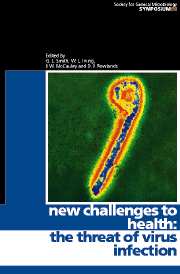Book contents
- Frontmatter
- Contents
- Contributors
- Editors' Preface
- 1 The viruses in our past, the viruses in our future
- 2 Dynamics and epidemiological impact of microparasites
- 3 The continuing threat of bunyaviruses and hantaviruses
- 4 Calicivirus, myxoma virus and the wild rabbit in Australia: a tale of three invasions
- 5 Potential of influenza A viruses to cause pandemics
- 6 The hepatitis viruses as emerging agents of infectious diseases
- 7 The emergence of human immunodeficiency viruses and AIDS
- 8 Morbilliviruses: dangers old and new
- 9 Structure–function analysis of prion protein
- 10 Endogenous retroviruses and xenotransplantation
- 11 Gammaherpesviral infections and neoplasia in immunocompromised populations
- 12 Structure and function of the proteins of Marburg and Ebola viruses
- 13 Epidemic dengue/dengue haemorrhagic fever as a public health problem in the 21st century
- 14 Borna disease virus – a threat for human mental health?
- 15 Antiviral drug development and the impact of drug resistance
- Index
5 - Potential of influenza A viruses to cause pandemics
Published online by Cambridge University Press: 06 July 2010
- Frontmatter
- Contents
- Contributors
- Editors' Preface
- 1 The viruses in our past, the viruses in our future
- 2 Dynamics and epidemiological impact of microparasites
- 3 The continuing threat of bunyaviruses and hantaviruses
- 4 Calicivirus, myxoma virus and the wild rabbit in Australia: a tale of three invasions
- 5 Potential of influenza A viruses to cause pandemics
- 6 The hepatitis viruses as emerging agents of infectious diseases
- 7 The emergence of human immunodeficiency viruses and AIDS
- 8 Morbilliviruses: dangers old and new
- 9 Structure–function analysis of prion protein
- 10 Endogenous retroviruses and xenotransplantation
- 11 Gammaherpesviral infections and neoplasia in immunocompromised populations
- 12 Structure and function of the proteins of Marburg and Ebola viruses
- 13 Epidemic dengue/dengue haemorrhagic fever as a public health problem in the 21st century
- 14 Borna disease virus – a threat for human mental health?
- 15 Antiviral drug development and the impact of drug resistance
- Index
Summary
INTRODUCTION
The last century ended with heightened awareness of an impending influenza pandemic, i.e. a major worldwide epidemic caused by the emergence of a novel influenza A subtype against which the population has little or no immunity. The ‘bird ‘flu’ (H5N1) outbreak in Hong Kong in 1997, which claimed the lives of six of its 18 victims, was terminated at the end of the year by the slaughter of the poultry in the live bird markets, which removed the source of infection (Claas et al., 1998; Subbarao et al., 1998; Bender et al., 1999). Shortly after, in late 1998 in southern China and in early 1999 in Hong Kong, cases of mild influenza caused by another influenza A subtype, H9N2, indicated that the repopulated bird markets still harboured potential human pathogens (Peiris et al., 1999; Lin et al., 2000). Most of these infections resulted from avian-to-human transmission and there was little evidence of human-to-human spread; neither virus became established (as yet) in the human population (Bridges et al., 2000; Katz et al., 1999). The high mortality associated with influenza A H5N1 infection (of both chickens and people) raised the spectre of a recurrence of a 1918–1919-like pandemic which is estimated to have claimed in excess of 40 million lives worldwide (Crosby, 1989).
- Type
- Chapter
- Information
- New Challenges to HealthThe Threat of Virus Infection, pp. 89 - 104Publisher: Cambridge University PressPrint publication year: 2001



